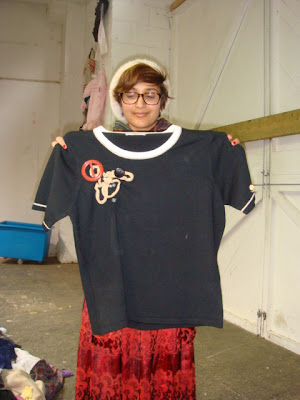Last week, from 17~22/1/12, I had the pleasure of working with Everything Must Go!
The installation process went on from the 17th until the 19th of January.
The installation process went on from the 17th until the 19th of January.
 |
| Photo: Tim Mitchell |
INSTALLATION: Myself and David were in charge of painting the yarn holders one fine, chilly morning...
The above grid photo and all photographs for the exhibition were taken by Tim Mitchell. You can find Tim’s vast portfolio here: Tim Mitchell Photography
Tim Mitchell worked on a time lapse photography project of ship breaking for Waste of the World’s research which was used in Everything Must Go. See Instagram: @mrtimmitchell
Tim Mitchell worked on a time lapse photography project of ship breaking for Waste of the World’s research which was used in Everything Must Go. See Instagram: @mrtimmitchell
 |
| Above photo: Tim Mitchell |
FACTS: Everything Must Go was a culmination of a five year social science research program called Waste of The World. Waste of The World was funded by the Economic and Social Research Council. You can view the press release page on their website here: Waste of The World
"Dr Lucy Norris (UCL Anthropologist) has spent the last five years researching textile recycling as part of Waste of the World, an academic research project investigating global flows of waste including textiles, food, ship breaking and nuclear energy.
For the end-of-project event, Waste of the World collaborated with a group of artists and designers to present a public exhibition that tells the textile story. The exhibition was co-curated by Dr Lucy Norris and artist Clare Patey, and produced by arts organisation Holy Mountain."
THE EXHIBITION:
As you entered the Bargehouse building you were greeted by a shockingly huge mound of recycled clothing...
The entrance space was known as our charity shop. Second hand clothing hovered, hung high on the charity shop’s wall to serenade the guests as they walked in...
Guests were invited to bring an old item of clothing with them to recycle with us, and guests who wanted to buy a second hand item of clothing could donate an amount they thought the garment was worth. This interactive part of the exhibition’s process was a great way to meet our guests and to get their perspectives and opinions on second-hand clothing, their unwanted goods and ultimately their “waste”. The money that was raised at the exhibition went to Oxfam. We all love Oxfam.
Here's some examples of why we get rid of our clothing and how much we think it's worth...
Here's some examples of why we get rid of our clothing and how much we think it's worth...
 |
| "no longer fit.. £2-£5" |
 |
| "because I was asked to bring something.. - £20" |
 |
| "it doesn't suit me, bad purchase, I brought it from a charity shop... £1.50" |
As the guests wandered up the two flights of stairs they were greeted with years’ worth of informative, challenging texts.
The lovely ReMade in Leeds team were busy upstairs upcycling old garments ready to be worn again, guests were invited to join them.
The Frip Ethique room was just next door to ReMade in Leeds, find out more about Frip Ethique and their great scheme here: Frip Ethique
UPCYCLING: A before and after photo of an unwanted item of clothing...
“Remade in Leeds is a Leeds based sustainable fashion boutique offering workshops, events and clothing collections under our in-house brand, Antiform." ~ taken from ReMade in Leeds
The Frip Ethique room was just next door to ReMade in Leeds, find out more about Frip Ethique and their great scheme here: Frip Ethique
UPCYCLING: A before and after photo of an unwanted item of clothing...
 |
| Above: Before |
 |
| Above: After! After an upcycle session the t-shirt breathes new life |
“Frip Ethique is an Oxfam-run initiative based in Senegal’s capital, Dakar, which sorts and sells clothing from the UK to local second-hand merchants." ~ taken from Oxfam's Fashion Blog
See Tim Mitchell’s great set of images of the exhibition here:
http://gallery.me.com/mrtimmitchell#100750
| SATURDAY, TALKING RUBBISH: The exhibition was full by 11:30am for Saturday’s talks,
Talking Rubbish consisted of:
ALTERNATIVE
PERSPECTIVES ON THE USED CLOTHING TRADE
Chair: Professor Nicky Gregson, Durham University
NEW
MODELS: RECYCLING, UPCYCLING AND CLOSING THE LOOP
Chair: Lucy Siegle, Journalist & Broadcaster
|
All talks were FASCINATING and inspiring, quite overwhelming...
I particularly wanted to see Kate Goldsworthy’s talk, being so enamoured by the work that she does. Kate Goldsworthy’s research and design work is focused on material innovation and design for recycling, Kate is Course Director of MA Textile Futures at Central Saint Martins University; such fascinating work they do. Find out more about Kate Goldsworthy here: K. Goldsworthy
ALL IN ALL: Everything Must Go challenged our perceptions and knowledge of the textiles recycling industry, gave us insight into the lives of others that work with textiles and our unwanted goods, inspired us with those that are trying to make a difference, taught us to challenge our awareness and ultimately tackle the issue of what can be/should be/is being done to minimise waste. FANTASTIC WORK AND... everyone was so nice.
Thanks to all involved in Everything Must Go, it really was a pleasure.
Yuli
X
Thanks to all involved in Everything Must Go, it really was a pleasure.
Yuli
X











